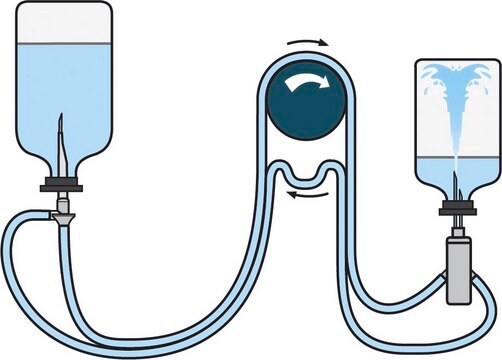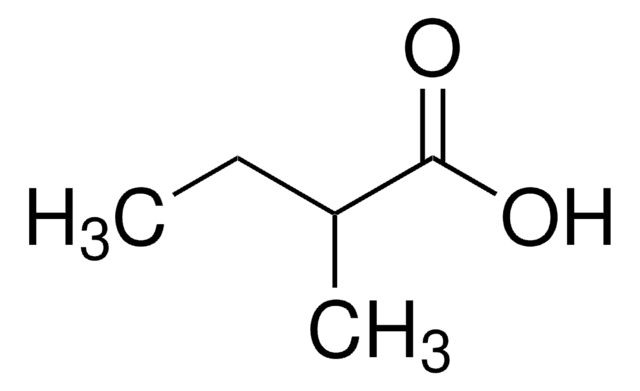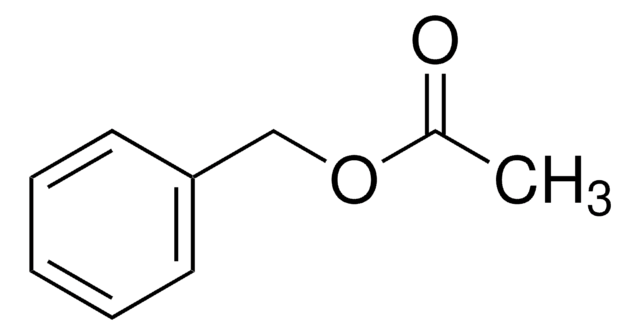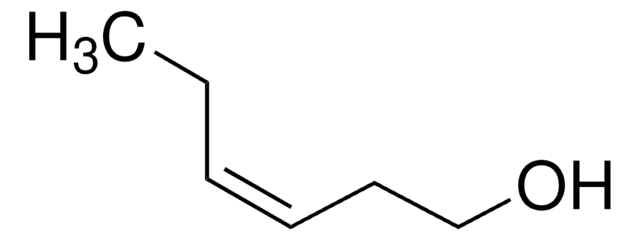W242713
Ethylbuttersäure
natural, ≥98%, FCC, FG
Synonym(e):
Ethyl-butyrat
About This Item
Empfohlene Produkte
Qualität
FG
Fragrance grade
Halal
Kosher
natural
Qualitätsniveau
Agentur
follows IFRA guidelines
meets purity specifications of JECFA
Einhaltung gesetzlicher Vorschriften
EU Regulation 1223/2009
EU Regulation 1334/2008 & 178/2002
FCC
FDA 21 CFR 117
Dampfdichte
4 (vs air)
Dampfdruck
15.5 mmHg ( 25 °C)
Assay
≥98%
Selbstzündungstemp.
865 °F
Grünere Alternativprodukt-Eigenschaften
Less Hazardous Chemical Syntheses
Use of Renewable Feedstocks
Learn more about the Principles of Green Chemistry.
Brechungsindex
n20/D 1.392 (lit.)
bp
120 °C (lit.)
mp (Schmelzpunkt)
−93 °C (lit.)
Dichte
0.875 g/mL at 25 °C (lit.)
Anwendung(en)
flavors and fragrances
Dokumentation
see Safety & Documentation for available documents
Nahrungsmittelallergen
no known allergens
Allergener Duftstoff
no known allergens
Grünere Alternativprodukt-Kategorie
Organoleptisch
ethereal; fruity; pineapple; sweet
SMILES String
CCCC(=O)OCC
InChI
1S/C6H12O2/c1-3-5-6(7)8-4-2/h3-5H2,1-2H3
InChIKey
OBNCKNCVKJNDBV-UHFFFAOYSA-N
Suchen Sie nach ähnlichen Produkten? Aufrufen Leitfaden zum Produktvergleich
Allgemeine Beschreibung
Anwendung
- Tracer aroma compound transfer from a solid and complex-flavored food matrix packed in treated papers or plastic packaging film.: Investigates the transfer dynamics of aroma compounds from food products, essential for optimizing food packaging materials to preserve flavor integrity (Dury-Brun C et al., 2007).
Signalwort
Warning
H-Sätze
Gefahreneinstufungen
Flam. Liq. 3
Lagerklassenschlüssel
3 - Flammable liquids
WGK
WGK 1
Flammpunkt (°F)
78.8 °F - closed cup
Flammpunkt (°C)
26 °C - closed cup
Persönliche Schutzausrüstung
Eyeshields, Faceshields, Gloves, type ABEK (EN14387) respirator filter
Analysenzertifikate (COA)
Suchen Sie nach Analysenzertifikate (COA), indem Sie die Lot-/Chargennummer des Produkts eingeben. Lot- und Chargennummern sind auf dem Produktetikett hinter den Wörtern ‘Lot’ oder ‘Batch’ (Lot oder Charge) zu finden.
Besitzen Sie dieses Produkt bereits?
In der Dokumentenbibliothek finden Sie die Dokumentation zu den Produkten, die Sie kürzlich erworben haben.
Kunden haben sich ebenfalls angesehen
Unser Team von Wissenschaftlern verfügt über Erfahrung in allen Forschungsbereichen einschließlich Life Science, Materialwissenschaften, chemischer Synthese, Chromatographie, Analytik und vielen mehr..
Setzen Sie sich mit dem technischen Dienst in Verbindung.















